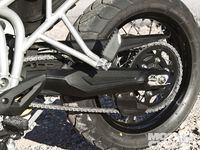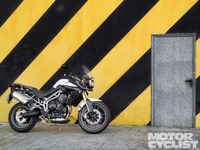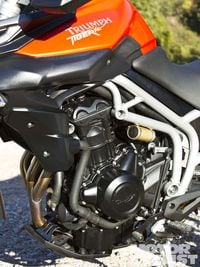Forget everything you know about any earlier Triumph with Tiger on its tank. Triumph did. One sighting lap of the bike outside our four-star base camp 45 minutes west of Barcelona and even hopelessly jet-lagged eyes can see this is an entirely different animal. Though they will share showroom space in 2011, the new Tiger 800 and the more dirt-worthy 800XC share about as many visual and functional similarities with the street-biased Tiger 1050 as they do with a 1967 TR6/C.
When they started turning a fistful of ideas into what you see here back in April 2007, Hinckley's engineers knew these Tigers had to be different from anything they'd done before. They needed top-notch pavement manners _and _credible off-road performance. Customers were pleading for an accessible seat height. Switchable ABS had to be on the options list. Both bikes would rise from the same basic three-cylinder platform, but according to Triumph Product Manager Simon Warburton, "We didn't have an engine for the kind of bike we wanted to build." So? They built a new one.
The Tiger's 12-valve inline-triple shares its basic floor plan with the Daytona 675, along with about 15 percent of that engine's parts manifest: 74mm cylinder bores, wet-sump lubrication, stacked gearbox shafts, buzz-killing balance shaft ahead of the new long-stroke crank. It uses the same connecting rods and cylinder-head casting as well, along with the same sort of labyrinth crankcase breather behind the cylinders. Goodbye, dipstick: A sight glass on the right side of the sump reveals oil level. Most everything else is new. An oil-cooled 645-watt alternator provides 61 percent more juice than the one in BMW's F800GS-enough electrical impetus to run auxiliary lights, a GPS, electric vests and various other adventurous paraphernalia without flattening the battery. Running the swingarm pivot through the crankcase casting simplifies the steel-tube frame.
Steel? Aside from being tougher than aluminum, it's easier to find a good TIG welder if you break something in Saskatoon or Puntas Arenas. The 800XC rides on a 45mm non-adjustable fork followed by a remote-reservoir shock that offer more travel than the base Tiger 800 bits. Off-road-ready wire-spoke wheels wear Bridgestone Battle Wing rubber. The 21-inch front and extra-long adjustment slots in the aluminum swingarm give the XC more dirt-friendly chassis geometry than the standard Tiger.
One more double triple-espresso brings my caffeine levels up to scratch and it's time to see if all those parts add up to anything. With the seat in its tallest position, the Tiger XC is markedly taller than a Tiger 800. Its tapered aluminum handlebar is wider as well. There's plenty of room for long arms and legs, even with the two-position bar risers in the standard slot. The compact instrument pod crams a lot of information into relatively little space if you're willing to squint. Awakening more readily than a jet-lagged journalist, the triple settles into its signature cadence like a pint-sized British turbine. The spec sheet says a fully fueled XC weighs 473 lbs.-11 more than the standard Tiger and an alleged 18 lbs. more than BMW's listed wet weight for the 2011 F800GS, though it feels lighter from the saddle.
Two quick tips about riding in Spain: Most Spaniards drive like lunatics, and the majority of Spanish pavement offers roughly as much grip as a granite countertop. No worries: Whistling into a high-speed gauntlet of off-camber on-ramps, Seat Ibiza diesels and homicidal truck drivers channeling Fernando Alonso, the Tiger is relaxed. It takes a bit more effort to flick the taller XC through a Spanish roundabout as quickly as its standard brother, and there are a few minor chinks in its urban armor. The front brake feels a bit spongy, and on/off throttle transitions could be smoother. Beyond that, the triple responds to a fistful of throttle with digital precision, laying down a steady stream of practical power from 1800 rpm. First gear feels a bit tall around town, and the clutch could engage a little sooner. On the plus side, shifting is ridiculously light and precise when you need to shift at all. There's sufficient torque on tap above 3000 rpm to make shifting optional unless you're in a hurry, which we apparently are.
Maintaining an authentic Spanish pace keeps the tach needle in the fun zone above 6000 rpm. The Tiger leaves slower traffic sprinting up to autopista speed. Compliant suspension delivers a comfortably taut ride. Long gearing keeps the counterbalanced triple nice and smooth at 75 mph. The standard windscreen does an admirable job at that speed, but 6-footers will opt for Triumph's taller, wider accessory unit.
Arcing off into the twisty bits, the XC rails around fast bends. With some extra spring preload and rebound damping dialed into the shock, it's agile enough in the tight ones to make you want to turn around and have another go. The front brake still feels too spongy for our taste, but unlike some other mid-size adventurers with this much suspension travel, there's no pucker-inducing chassis pitch when you're trying to scrub off 60 mph for a looming second-gear switchback. Nothing drags at the apex, but fair warning: Launch this triple out of a dozen bends like that at 8000 rpm and you're ruined for anything else.
The next 12 miles of rutted, rocky, washout-infested dirt could ruin everything. But shod with a set of suitably knobby Metzeler Karoos, the XC makes anything more feel like a whole lot less. Reined to a semi-sane pace, it's sure-footed and responsive enough to go around anything basic physics says you can't go over or through. Surfing the fat part of the torque curve in second gear with a half-tank of gas and another narrow-gauge rollercoaster of smooth Spanish pavement to ride before dinner, one thing seems fairly certain: If there's a better motorcycle for this sort of thing, we haven't ridden it yet.
tech SPEC
Evolution
A stroked, 800cc version of the Daytona 675 triple, mounted in a burly steel-trellis, long-travel chassis to create a go-anywhere middleweight adventure bike.
Rivals
BMW F800GS, Kawasaki Versys, Suzuki V-Strom 650.
TECH
TRIUMPH TIGER 800XC
Price: $10,999
Engine type: l-c triple
Valve train: DOHC, 12v
Displacement: 799cc
Bore x stroke: 74.0 x 61.9mm
Compression: na
Fuel system: EFI
Clutch: Wet, multi-plate
Transmission: 6-speed
Claimed horsepower: 94 bhp @ 9300 rpm
Claimed torque: 58 lb.-ft. @ 7850 rpm
Frame: Tubular-steel trellis
Front suspension: 45mm Showa fork
Rear suspension: Showa shock with remote adjustable spring preload and rebound damping
Front brake: Dual Nissin two-piston calipers, 308mm discs
Rear brake: Nissin single-piston caliper, 255mm disc
Front tire: 90/90-21 Bridgestone Battle Wing
Rear tire: 150/70-17 Bridgestone Battle Wing
Rake/trail: 23.1o/3.6 in.
Seat height: 33.2 in.
Wheelbase: 61.7 in.
Fuel capacity: 5.0 gal.
Claimed wet weight: 473 lbs.
Color: Phantom Black, Intense Orange, Crystal White
Available: Now
Warranty: 2 yrs., unlimited mi.
Contact: Triumph Motorcycles America
385 Walt Sanders Memorial Dr. #100
Newnan, GA 30265
678.854.2010
www.triumphmotorcycles.com
Verdict 4 out of 5 stars
Best Triumph Tiger yet, and sure to give BMW's middleweight GS a run for its money.

















/cloudfront-us-east-1.images.arcpublishing.com/octane/VZZXJQ6U3FESFPZCBVXKFSUG4A.jpg)
/cloudfront-us-east-1.images.arcpublishing.com/octane/QCZEPHQAMRHZPLHTDJBIJVWL3M.jpg)
/cloudfront-us-east-1.images.arcpublishing.com/octane/HXOUJXQWA5HBHGRO3EMJIGFMVI.jpg)

/cloudfront-us-east-1.images.arcpublishing.com/octane/3TIWWRV4JBBOLDVGRYECVVTA7Y.jpg)
/cloudfront-us-east-1.images.arcpublishing.com/octane/KIX5O23D5NAIBGFXBN3327DKZU.jpg)
/cloudfront-us-east-1.images.arcpublishing.com/octane/7GJYDUIPXRGMTMQKN6ONYOLBOU.jpg)
/cloudfront-us-east-1.images.arcpublishing.com/octane/MUQLOVLL2ZDGFH25ILABNBXKTI.jpg)
/cloudfront-us-east-1.images.arcpublishing.com/octane/TNOU5DNE2BC57MFPMGN2EIDXAM.jpg)
/cloudfront-us-east-1.images.arcpublishing.com/octane/GTCXACQGJ5HAPDTGWUQKDEH44E.jpg)
/cloudfront-us-east-1.images.arcpublishing.com/octane/S35YGSEMEZB4BLTDJTSZPF4GLA.jpg)
/cloudfront-us-east-1.images.arcpublishing.com/octane/5UOT6HPX2JFMRJAX6EH45AR4MQ.jpg)
/cloudfront-us-east-1.images.arcpublishing.com/octane/OKWOJWAKP5EP3OACCRRWPCIX2Q.jpg)
/cloudfront-us-east-1.images.arcpublishing.com/octane/2WF3SCE3NFBQXLDNJM7KMXA45E.jpg)
/cloudfront-us-east-1.images.arcpublishing.com/octane/G4MG6OUCJNBSHIS2MVVOTPX65E.jpg)
/cloudfront-us-east-1.images.arcpublishing.com/octane/IIGGWFOTOJGB7DB6DGBXCCMTDY.jpg)
/cloudfront-us-east-1.images.arcpublishing.com/octane/QSTCM6AVEZA5JJBUXNIQ3DSOF4.jpg)
/cloudfront-us-east-1.images.arcpublishing.com/octane/U4I7G625B5DMLF2DVIJDFZVV6M.jpg)
/cloudfront-us-east-1.images.arcpublishing.com/octane/B6XD6LS6IVCQPIU6HXDJSM3FHY.jpg)
/cloudfront-us-east-1.images.arcpublishing.com/octane/ICL63FEDDRDTTMINYICCEYGMDA.jpg)
/cloudfront-us-east-1.images.arcpublishing.com/octane/FCGZHQXRBZFLBAPC5SDIQLVF4I.jpg)
/cloudfront-us-east-1.images.arcpublishing.com/octane/WNOB6LDOIFFHJKPSVIWDYUGOPM.jpg)

/cloudfront-us-east-1.images.arcpublishing.com/octane/X33NU3E525ECRHXLNUJN2FTRKI.jpg)